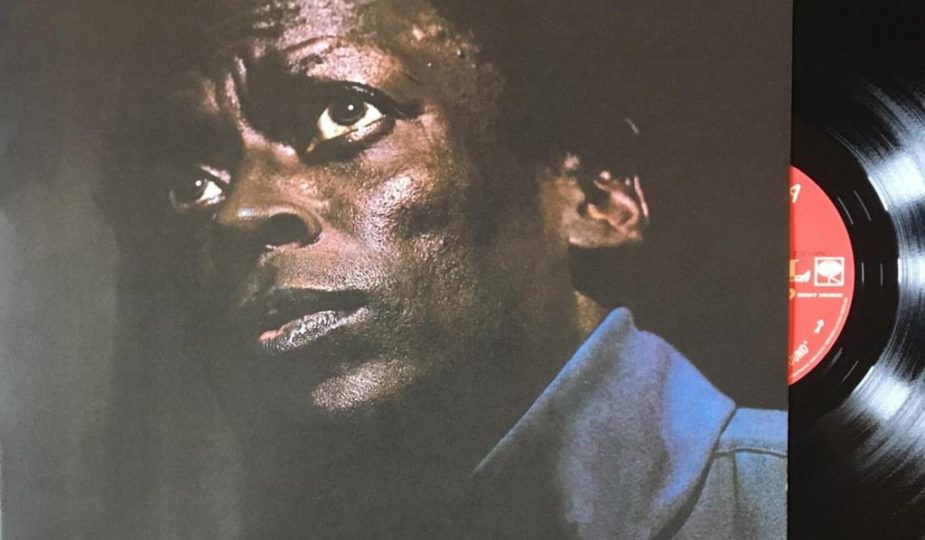
Miles Davis and His Musical Revolution – on the 50th Anniversary of ‘In a Silent Way’
by Mark Lager
The humming of the church organ followed by the tentative, two-note guitar strum heralds the testimonial to begin the revival of the night. The groove of the movement of the people. Doors opening at each pluck of the bass. Stepping in files to the shimmer of the cymbals. The pulpit being assembled to the electric piano while the Hammond organ fuzzes onwards with its church chime and Fender Rhodes raindrops fall outside the darkened stained glass windows. The guitar continues its winding solo of the wanderer and the seeker, the shepherd who will guide his flock of sheep. All of it seems to dissolve in a moment of silence where all stops except the drone of the organ. The congregation stands as the cymbals return. Each stroke of the bass is a door opening on either side of the altar. The lone savior, the sacrificed, emerges out of the darkness and into the light as a trumpet blares. What else does this music ask, but…? Shh…quiet, now, brothers and sisters, there will be no talk of fire and brimstone tonight. There will be talk of city streets and city walls, city lights and city halls, the city that will rise, the city that will fall. His voice rises out through the ceiling, becomes a midnight wind, stirring the trees on the sidewalk and the tires of cars as they glide deathly still through the illuminated glow of butterscotch lamps and over bridges and under bridges and between towering buildings and past deserted neighborhoods. A saxophone shambles and shuffles along backroads, railroads, and paths which curve through the park.
We are listening to the city at night, but we hear only the nothingness of silence. We are back inside the church as the humming of the organ and the tentative, two-note guitar strum return us to the revival.
What was this truth so deep and profound that it could not be spoken in words but only carried on the night wind through the streets in acts of silence?
It was revolution.
It was that which is called peaceful.
The revolution will not be televised. The revolution occurs in a silent way. All which is silent is that which is real. Night is revealed to be the nature of things, while day obscures this internal mantra, OM, vibrating Hammond organ of the heart. The guitar softly weeps the tears of the eternal folk song, while the Fender Rhodes is no longer raindrops falling outside but teardrops falling inside. It seems the one thousand year long day will never be redeemed or renewed.
The shepherd has become the lamb. The wanderer saxophone sadly realizes his poverty and his war while also recognizing the poverty and the war.
The trumpet mirrors his call with his response.
I am the lamb. I have seen the mountaintop. I may not get there with you, but I have said to you: “Shh…be peaceful.” I have seen it in a silent way and you can see it for yourselves if you only hear that true revolution music in your heart, not in your hands.
It is 1968. It is Martin Luther King, Jr. with the mountaintop speech the night before his April death, the morning glory of the spring.
It is Robert Kennedy with his nomination speech the night of his June death, the evening herald of the summer.
It cannot be in a silent way.
It’s about that time! The counterculture and psychedelia of rock music shouts, its own sweat, blood, and tears spilled from folk and blues, its own ideals enshrined in the cathedral of jazz.
This is the promise of progress now, in the night, not in Atlantis.
Jimi Hendrix had been the first voice that summer of 1968 with his voyage to Electric Ladyland. A new location where he burned the midnight lamp and went underwater to drown in the amniotic chrysalis of his birth. It wasn’t a geographical location. It was a cosmic location, a consciousness location.
Miles Davis walked alone in that elusive and vague, spacey and strange, revival of night which was revolution. Yet he was not truly alone. He was being guided by his sheep, although he was the shepherd. Now it was his voice which was traveling out of the cathedral of jazz into the night winds where folk, blues, and rock stirred. The sheep were the shepherds. They felt the wind in their bones and wandered. In this wandering, Miles was the leader not because he was the lion but because he was the lamb.
Wayne Shorter on soprano saxophone, Dave Holland on upright bass, Tony Williams on percussion, Joe Zawinul on Hammond organ, Herbie Hancock on electric piano, Chick Corea on Fender Rhodes keyboard, and John McLaughlin on electric guitar–all children traveling with Miles through the holy ruins of the camel, the violent riots of the lion, to get to the true promised land which is not called revolution but is called peaceful.
It is only the child that does not need to say “Shh.”
It is only the child that can truly be rather than say- not say the no of “shh” but say the yes of “peaceful.”
That’s what the shepherd becomes with the sheep. He becomes the lamb who is both sacrificed and savior as the trumpet speaks without structure, with a total freedom provided by the children as they play: an endless, ethereal spinning wheel of open-ended, funky grooves and soulful meditations, folklike solo melodies and jazzy group harmonies. No genre boundaries or definitions but embracing and encompassing all. No lyrics or words but sounds that spoke the hidden and secret letter inscribed within the name of your heart.
In a Silent Way dawned on February 18, 1969. It was the last year of the decade. Night had been obscured, but In a Silent Way spoke of that night which is called peaceful by not speaking. They said “yes” without saying “no.” No boundaries or definitions or words. They were in that jazz church revival, but it was a revival of the night which remembered that its wandering sheep, its children of the street, remained the guides. Miles Davis and his crew were granting the blessings to the worship of those raindrops and teardrops, that sweat, blood, and tears, transfigured in the stained glass of the saviors and sacrifices, such as Martin Luther King, Jr. and Robert Kennedy.

[…] In Green’ from Kind of Blue. Or to ‘Shhh’ and the album In A Silent Way (1969- read our review here) in general. Sketches Of Spain probably still stands out today because Miles benefited from the […]
Great text! It really was a beautiful read. Thanks a lot for this.
Thank You so much.
Thank You Esa and Miles Fan.
Great tribute to a great record!
It was a real joy to read this. Thank you!
I’m glad you enjoyed it! Mark Lager writes great texts. If you want to stay up to date on articles, subscribe to our newsletter!